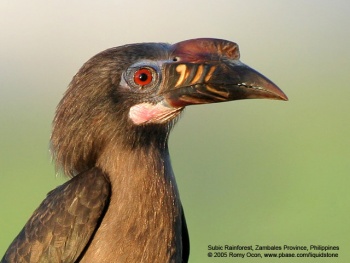Alternative name: Luzon Tarictic Hornbill
- Penelopides manillae
Identification
45cm. A small hornbill with a ridged bill.
Male
- Creamy on head, neck and underparts
- Blackish ear-coverts, cheeks and throat
- Dark brown upperparts and wings
- Pale band across tail
- Brown and black bill and small casque with pale yellow to pink ridges on both mandibles and pale tip
- Pinkish bare skin around eye and on throat
Female
- Smaller with all brown to black plumage
- Browner tailband
- Edged blue throat skin
Juveniles similar to adults of respective sex bu with smaller and dull brown bill
Distribution
Endemic to the northern Philippines.
A restricted-range species. Formerly common but declining due to habitat loss.
Taxonomy
Two subspecies recognized:
- P. m. manillae in the northern Philippines on Luzon, Marinduque, Catanduanes and some adjacent islets
- P. m. subniger on Polillo Island and Patnanongan Island
Formerly considered conspecific with the other species of this genus on the Philippines.
Habitat
Topical moist lowland forest. Occurs up to 900m.
Behaviour
Diet
Feeds on figs and other fruits, takes probably also insects and other small animals.
Breeding
Egg laying in March and April. A monogamous species with immature helpers from previous breeding seasons. Nests in a natural hole in a large forest tree. The breeding female is sealed in by the male. Lays 3-4 eggs.
Movements
A sedentary and territorial species.
References
- Del Hoyo, J, A Elliot, and J Sargatal, eds. 2001. Handbook of the Birds of the World. Volume 6: Mousebirds to Hornbills. Barcelona: Lynx Edicions. ISBN 978-8487334306
- Clements, JF. 2011. The Clements Checklist of Birds of the World. 6th ed., with updates to August 2011. Ithaca: Cornell Univ. Press. ISBN 978-0801445019. Spreadsheet available at http://www.birds.cornell.edu/clementschecklist/downloadable-clements-checklist
Recommended Citation
- BirdForum Opus contributors. (2024) Luzon Hornbill. In: BirdForum, the forum for wild birds and birding. Retrieved 14 May 2024 from https://www.birdforum.net/opus/Luzon_Hornbill





